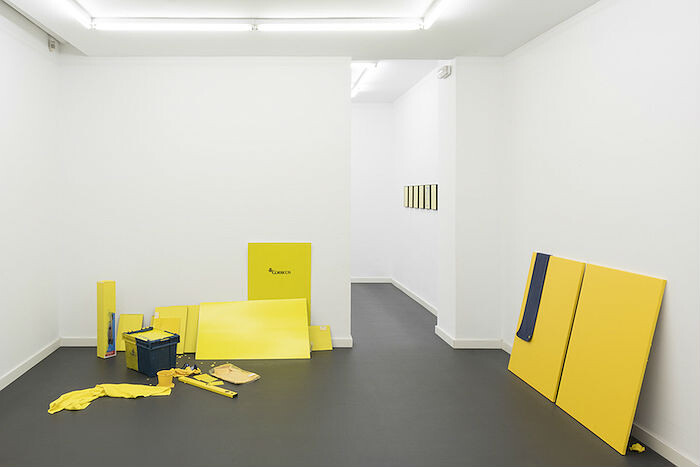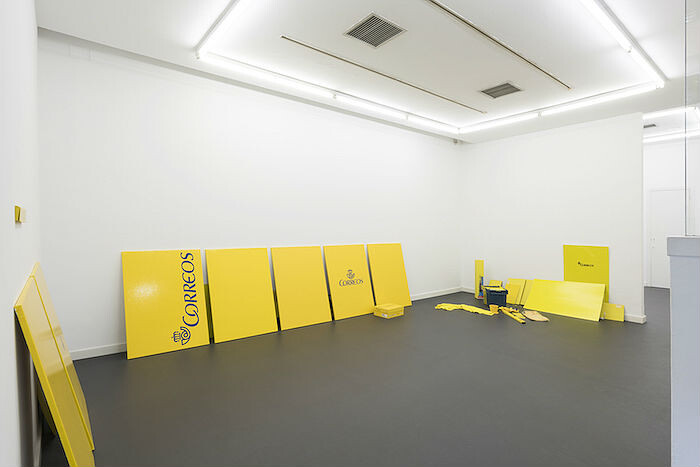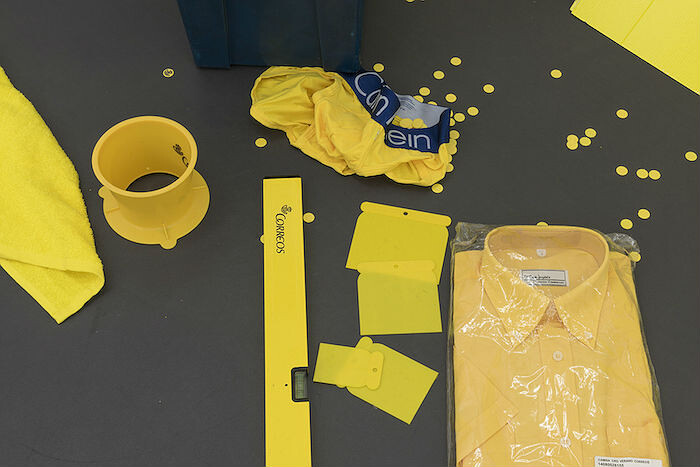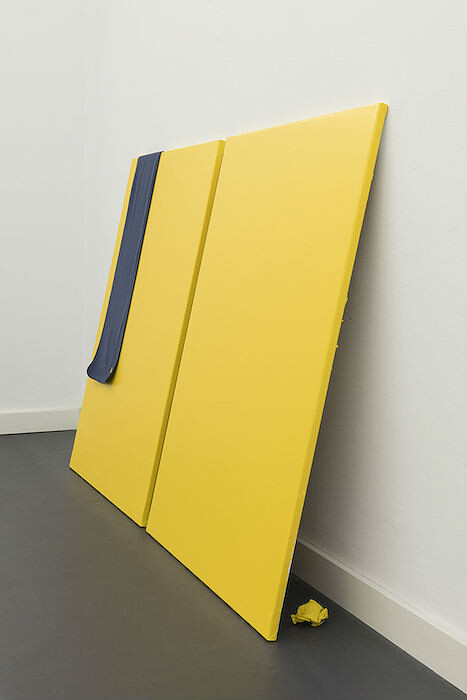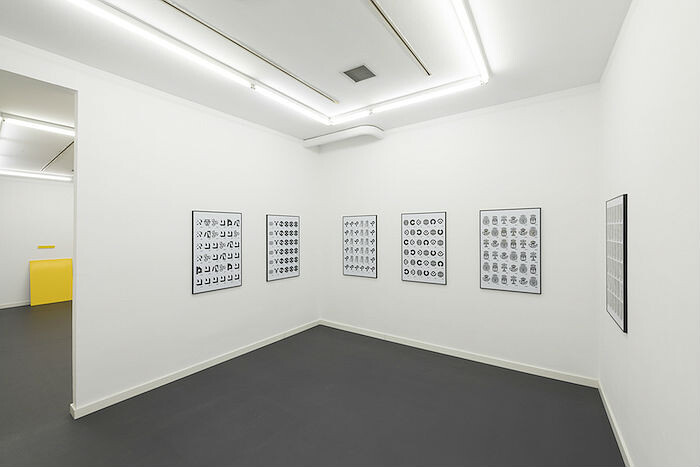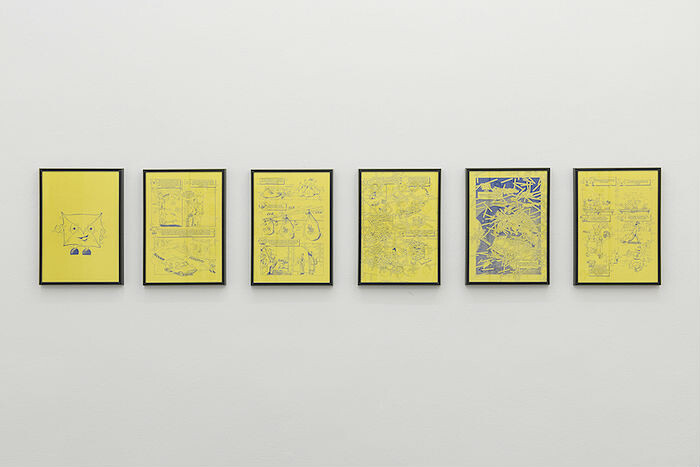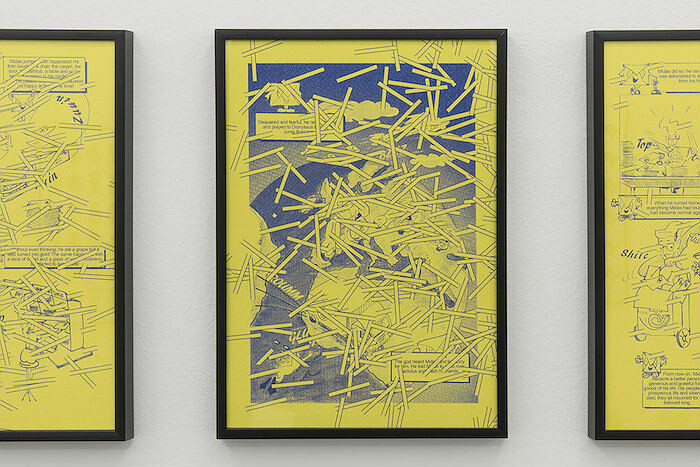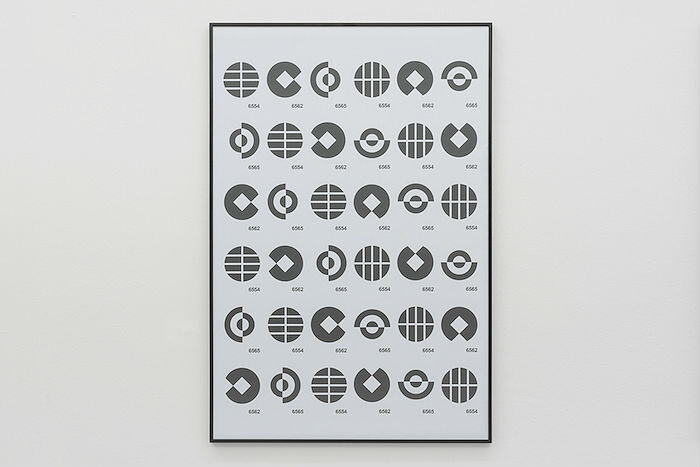Francesc Ruiz’s second solo show at Madrid’s garcía galería delves into the visual communication of one of Spain’s most iconic institutions, the Sociedad Estatal Correos y Telégrafos—the national postal service, commonly known as Correos—whose graphic identity was created in 1977 by Spanish designer and artist José María Cruz Novillo (b. 1936). Ruiz’s interest is not limited to Cruz Novillo’s pervasive design, but more broadly includes Correos as an agent of distribution as well as the various commercial guises that come into play in this public service. Ruiz’s choice to focus this exhibition on the postal system, the pre-eminent pre-internet network, is not casual: through his characteristic strategy of “expanded comics” he has long been concerned with the potential of distribution and official versus alternative forms of circulation.
“To design is to designate,” Cruz Novillo once declared.1 Since the late 1960s, he has been largely responsible for the construction of a Spanish institutional iconography, allocating enduring visual identities to copious private and state-owned companies such as ministerial departments, Renfe (Spanish National Railway Network), the PSOE (Spanish Socialist Workers’ Party) or the former peseta bank notes, to name only a few. Conferring fresh new identities on institutions following 40 grim years of dictatorship, design itself seemed capable of dusting off a murky past and embracing modernity and democracy.
The yellow of the Correos brand is the point for departure for Ruiz’s exhibition. Leaning sparsely against the gallery walls, the canvases that constitute Correos (I–IV) (all works 2015) sport the familiar livery of the Spanish post—from monochromes comprised only of its signature saturated golden color to compositions that incorporate its blue typography or horn-and-crown logo. Divided into four clusters, the paintings are supplemented by installations of branded merchandise, packaging, and other trappings of the postal system. A mailbox fitted to the wall like a portal above a canvas in Correos I (Buzón) [Post office I, (Mailbox)] seemingly turns the gallery into a postal franchise, both a sender and a receiver. Items of official clothing from the staff uniform are wittily incorporated: a scarf casually drapes over one painting (Correos II (Bufanda) [Post Office II (Scarf)]); a tie is carefully folded behind another (Correos III (Caja) [Post Office III (Box)]). Among this merchandised inventory Ruiz also stashes several discarded paper napkins behind the canvases, insinuating possible traces of clandestine sex. It is with Correos IV (Cartón) [Post Office IV (Cardboard)], however, the series’ most theatrically staged work, that its uniformity and minimal look go more wayward. Seemingly in an attempt to test the psychological rationale behind the company’s choice of hue, Ruiz scatters a range of yellowish and more or less plausibly branded items whose colors deviate from the sanctioned corporate tone. A pair of Calvin Klein men’s briefs, a spirit level, plastic spatulas, and a fluffy towel are either just-too-florescent, a little too mustard, or the result of sloppy color matching. New and unannounced postal elements will be progressively incorporated into this ostensibly haphazard cluster of items throughout the exhibition, mirroring Correos’s ceaseless circulation. Yet pointedly, the viewer is left to guess which elements are graphic inconsistencies that exist within the brand and which are mischievous additions of Ruiz’s devising.
In Marcar [To mark], Ruiz reprises his signature grids printed on paper to delve more comprehensively into Cruz Novillo’s overreaching influence. Here Ruiz connects Cruz Novillo’s economy of form with concerns shared by both the artist and his subject: seriality and permutation. Six black-and-white printed panels repeat and rotate a selection of the many Cruz Novillo-designed logos that still form an integral part of the Spanish graphic landscape. Ruiz’s groupings follow a binary logic: on the one hand, those pertaining to public or private organizations—construction and property developers, communication entities, state-owned companies—are grouped together. On the other hand are those that obey a more humorous raison d’être—exemplifying the playfulness that’s often a feature of Ruiz’s work—for example, logos that appear like cheeky eyes staring out at the viewer. Resembling a visual memory card game of decontextualized shapes, the prints leave one to speculate about the persistence of the logos’ personalities, and how their familiarity has been so assimilated into Spanish civic life.
In THE MIDAS TOUCH, Ruiz adapts a 1999 comic book published by Correos narrating the journey of a letter as it travels from sender to recipient into a series of six framed prints on yellow paper. Ruiz supplants the original story with the myth of King Midas, the monarch cursed by his ability to turn everything he touched into gold, including, fatefully, his own daughter. Correos’s low-key public-relations tool becomes, in Ruiz’s hands, a subtle critique of the perils of the free market—the Spanish government’s monopoly on providing postal services was opened up to competition in 2011. Correos is here much more than a case study of a Spanish brand that has seemingly kept its core function intact despite the political changes of the last 40 years. As Ruiz demonstrates, its visual logic seems to betray a degree of inconsistency and doubt as its operations have diversified. Moreover, as it exploits the symbolic connections between the corporate yellow and the value of gold, and the careful-what-you-wish-for moral of the Midas story, Ruiz’s shrewd exhibition astutely addresses the pitfalls of the liberalization of public-sector services.
Manuel Álvarez Junco, Colección Creativos No. 3 (Cuenca: Centro de Diseño de Castilla-La Mancha, 2011): 3.
